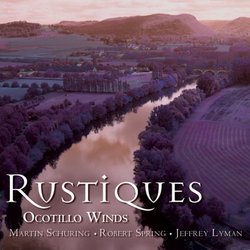| All Artists: Joseph Canteloube, Alexandre Tansman, Erwin Schulhoff, Heitor Villa-Lobos, Ocotillo Winds Title: Rustiques Members Wishing: 0 Total Copies: 0 Label: Summit(Classical) Original Release Date: 1/1/2006 Re-Release Date: 10/10/2006 Genre: Classical Styles: Chamber Music, Historical Periods, Classical (c.1770-1830), Modern, 20th, & 21st Century Number of Discs: 1 SwapaCD Credits: 1 UPC: 099402466927 |
Search - Joseph Canteloube, Alexandre Tansman, Erwin Schulhoff :: Rustiques
 | Joseph Canteloube, Alexandre Tansman, Erwin Schulhoff Rustiques Genre: Classical
If music, like wine, is evaluated in terms of vintages, then 1927 was a very good year for the trio d'anches, or reed trio, typically comprised of an oboe, a clarinet, and a bassoon. 1927 heralded the creation in Paris ... more » |
Larger Image |
CD Details
Synopsis
Album Description
If music, like wine, is evaluated in terms of vintages, then 1927 was a very good year for the trio d'anches, or reed trio, typically comprised of an oboe, a clarinet, and a bassoon. 1927 heralded the creation in Paris of an elite ensemble with three of the city's most eminent players: oboist Myrtil Morel, clarinetist Pierre Lefebvre, and the group's founder, bassoonist Fernand Oubradous. Also that year and in the same city, Max Eschig published Heitor Villa-Lobos' daring Trio for oboe, clarinet and bassoon, and in Prague the radically eclectic Ervin Schulhoff completed his Divertissement for the same instrumental combination. Alexander Tansman's Suite pour trio d'anches of 1949 is influenced by Stravinsky. Of all the works on the present disc, it is Rustiques by Joseph Canteloube that resonates most with wind players to this day. Known primarily for his Chants d'Auvergne, Canteloube again mined old French chansons and dances for inspiration, but this time he wove together tunes from all across the country.

 Track Listings (17) - Disc #1
Track Listings (17) - Disc #1